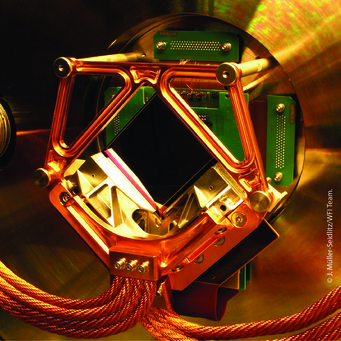The Athena X-ray Observatory
The Advanced Telescope for High-Energy Astrophysics (Athena) was selected in 2014 as the next large X-ray observatory in the ESA space program. It has been conceived to address some of Astrophysics' most pressing questions, which can be addressed with X-ray observations by combining unprecedented collecting area, survey capabilities and energy resolution. Athena’s answers are poised to transform our understanding of the Hot and Energetic Universe.
Athena’s scientific goals grow from two fundamental questions:
How did ordinary matter assemble into the large-scale structures we see today?
How do black holes grow and influence the Universe?
How did ordinary matter assemble into the large-scale structures we see today?
How do black holes grow and influence the Universe?

Example Athena/WFI science goals.
A. Rau/WFI Team

Athena/WFI Detector Module mounted in a vacuum chamber. The copper mounting and cooling interface surrounds the sensor's entrance window. The full-scale DEPFET sensor and the Detector Electronics are cooled separately to different temperatures.
J. Müller-Seidlitz/WFI Team.

The heart of the Detector Electronics of the Athena Wide Field Imager (WFI) is formed by a Frame Processing Module (FPM), which digitises and processes all analogue output signals of the Camera Head. The photo shows a prototype of the FPM hardware based on Field Programmable Gate Arrays (FPGAs).
J. Reiffers/WFI Team.


